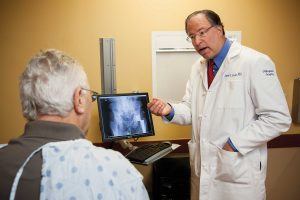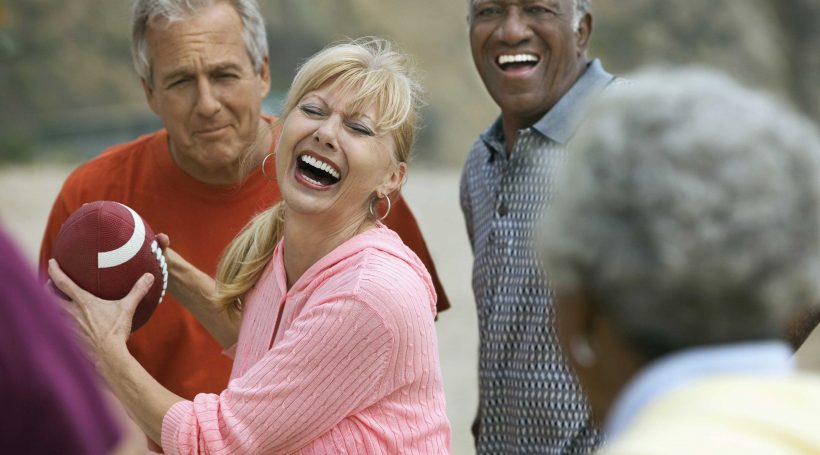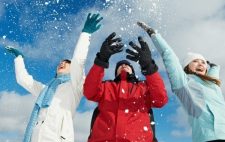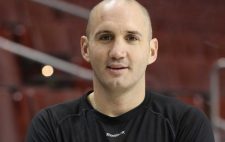These days, no one thinks twice when Aunt Janie jumps up to play in the family touch-football game. And when two middle-aged office pals grab their gym bags on the way out of the office, it’s not a big deal. Middle-aged adults are staying active well into their twilight years. That’s a good thing, except eventually, it’s gonna hurt.
Stuart Gordon, MD, was not ready to throw in the towel at 56. He played hard, via ice hockey and downhill skiing, and he worked hard as an orthopaedic surgeon. The pain started as a twinge in his right hip and eventually became a full-blown intrusion.
“I was walking, not more than two or three blocks, and the pain was so incapacitating. I couldn’t skate or pivot on the ice. Something was wrong,” says Gordon, head of the hip and knee replacement division at Cooper University Health Care’s Bone and Joint Institute. “I didn’t know I had it until my 50s when I saw the X-rays. It was mild hip dysplasia.”
Gordon, now 58, knew his years of rowing, college football and a run in the New York City Marathon worsened the misalignment of his hip joint. Two years ago, he had hip resurfacing surgery, which is an alternative to a total hip replacement. He had the same procedure done on his left side last month.
“I wanted to get back into life. I’ve been a competitive athlete my whole life, and I was not ready to give that up,” he says. “People who are young and athletic want their lives back.”
Gordon is one of many older adults who, unlike their counterparts 20 years ago, consider physical activity in their 50s and 60s a normal part of life. Think about it, when most of today’s adults were growing up, there weren’t many 50-year-olds going for a daily run or renewing their gym membership.
“I saw a patient the other day,” says Thomas Plut, DO, of Lourdes Sports Medicine. “He was 52 years old and he was experiencing knee pain. He played basketball five days a week. I encouraged him to cut back on how much basketball he was playing. His knees just can’t handle it anymore. I want him to do activities that aren’t so ground-pounding, like the elliptical, swimming, biking. That will allow him to continue to play basketball, but it’s also more of a preservation technique.”
 Doctors say society’s acceptance of older adults’ staying active – which they applaud – is also placing the population at risk for problems associated with the normal wear and tear of aging a bit earlier than usual.
Doctors say society’s acceptance of older adults’ staying active – which they applaud – is also placing the population at risk for problems associated with the normal wear and tear of aging a bit earlier than usual.
“People will have some aches and pains as they age. We are built to break down,” says Gordon. The knees, back and shoulders topped the list of patient complaints in 2010, numbering 18.6 million, 13.2 million and 11.5 million, respectively, according to the American Academy of Orthopaedic Surgeons. Keeping pace with the steep numbers, the American Chiropractic Association has determined 80 percent of the population will have a back problem at some point in their lives. Gordon says even those in seemingly perfect shape will feel twinges in their muscles and joints as they get older. It is just a matter of when.
A common complaint among active older adults is knee pain, says Plut. “Around the age of 50 is when we see a lot of arthritis symptoms come about, especially for the knee,” he says. “With certain activities, you can get a flare-up of your arthritis which can involve inflammation, and that can lead to pain. Some other symptoms of an arthritis flare-up are pain, swelling, joint stiffness or a feeling the knee wants to give way.
“There are some things we can do to help the patient continue with their activities,” adds Plut. “You change to lower-impact activities or do injections such as steroids. But outside of a knee replacement, there’s no cure for arthritis.”
While many adults may feel knee pain first, the aging process begins affecting the back during a person’s early 20s. With 33 vertebrae running top to bottom in the spine, there are 33 chances to feel a little bit older every time the leaves need raking.
“The different discs are like tires of a car with jelly in the middle. Tires, when aging, dry up and crack. We start losing water in these discs. It’s part of a normal process. It’s the first problem we see that leads to other issues,” says James Sanfilippo, MD, chief of the spine section and medical director of surgical services at Virtua Memorial Hospital. “Whether painful or not, everybody is going to have aging in the discs. The most common problems are at the very lowest point of the spine and at the curve of the neck. These discs have the most motion.”
Sounds cataclysmic, yet the average person – one with no degenerative or genetic conditions or early traumas – may not feel the difference for 20 more years.
It is usually after the fourth decade that doctors start to hear about sore backs, morning stiffness and neck pain.
“In our 40s, you may still be in great shape, but that is when we see the changes. The tendons are thinning and fraying. The joints are also like the tires of a car. The more miles they have, the more worn out they become,” says Christopher Carey, MD, of Orthopaedic Reconstruction Specialists in Voorhees. “You can’t blow off what is happening. The body doesn’t heal as well or as fast as it once did.”
These physicians agree the only way to make the reign of pain take a backseat is to exercise. All four advise making the activity habitual instead of cramming it into a Friday-Saturday-Sunday loop.
“Weekend warriors keep us busy,” says Gordon. “They do it all in one weekend, and the muscles aren’t as strong as you get older. The muscles don’t bounce back.”
Sanfilippo cannot stress enough that staying the course through consistent, low-impact activity is better than anything high-caliber, but irregular.
“Our muscles are so weak from not doing routine exercise, from being on computers 10 hours a day, that when we push them to the limit, a person winds up doing more damage,” he says.
Carey says overuse is what catches up to many of his patients. Joints, such as shoulders, have a range of motion that can chip away at what is initially there. It may provide a quick excuse to bypass a workout, but he says that will only do more harm than good.
“Do not stop exercising, but if you go to the well too often, the routine needs to be changed up,” he says. “The problems you get from being active are much better than the ones from being inactive.”
There are ways to keep fit safely, but Sanfilippo sees little of this in the many hard-charging home workout DVDs on the market. DVDs are great for fitting exercise into a busy schedule, he says, but they bring a high potential for injury.
“They are sold to people in their 30s, 40s and 50s,” he says. “If you are in shape, great. If you don’t get off the couch and then do these, it’s horrendous. People are doing them unsupervised with improper form. There are lots of shoulder injuries and knee injuries.”
Done mindfully and consistently, exercise will reap benefits down the road in the form of stronger muscles and well-lubricated joints that lead to better support for bones, the doctors say. Calcium and vitamin D can help, and Gordon recommends aerobics three days a week; strength training, such as lifting weights, three days a week; and flexibility and balance training six days a week.
“A great weakener as we age is the loss of balance and flexibility. You can lose your balance and fall,” he says. “People who strengthen their balance and flexibility, through something like yoga, are way ahead of the game.
“As we age, if we do nothing, the body will undergo changes and we won’t be able to stand up to the challenges. The question is, how can we maximize our potential? Keep trim. Keep active. Keep strong. Keep the mind active.”
Plut practices what he preaches to his patients, which is, as he says, “cross-train, cross-train, cross-train.”
“In my early 20s, I used to do a lot more running than I do now. I mix it up a lot more now – yoga, running, elliptical. I play basketball, I ride my bike during the spring and summer. I’m always doing something different, but I’m also focusing more on my core strength than I ever did before.”
Plut says athletes who mix up their activities will be able to stay active longer as they age. “If you have somebody who all they’ve been doing their whole life is run, run, run, run – that mode of exercise is going to catch up to those athletes a lot sooner as opposed to those who did more cross-training.”
The good news for aging athletes is they can continue to stay active as long as they are willing to make some adjustments when necessary, adds Plut. “People who are able to accept that their body is aging and breaking down will do the best, because they’re willing to be flexible and adjust. People who aren’t willing to accept that will struggle the most.”









